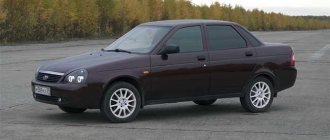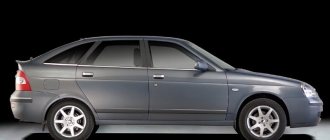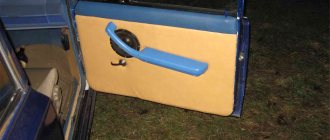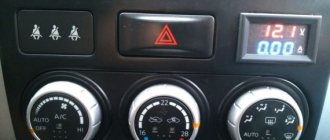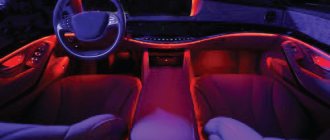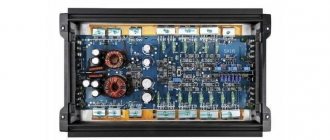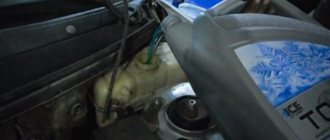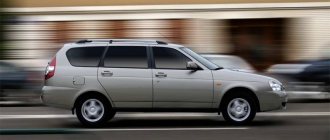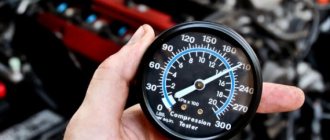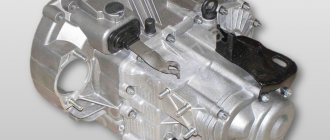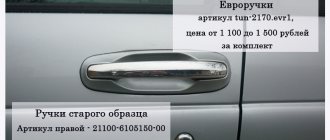When choosing a Priora, Toyota or Polo car, one of the first parameters that car enthusiasts pay special attention to is maximum speed, acceleration dynamics, and a strong, reliable engine. Acceleration to 100 km/h for the Priora is different, depending on the engine and body, as a rule, according to the passport - 11.5 seconds, 9.9 and even 9.5 seconds. A quick start is needed not only for racing competitions, but also for safe overtaking, as well as comfortable driving around the city. There are several ways to speed up the acceleration of the Priora - lightening the car, modifying the intake and exhaust systems, changing the firmware. But nothing will add power as much as tampering with the engine. For example, installing camshafts, turbines and non-standard throttle bodies. This is already a heavy tuning, it will increase both acceleration and wear of the engine - in this article we will not talk about it, but about acceleration at stock. Correct acceleration of the Lada Priora car from the factory.
For the Priora, acceleration to 100 km/h is recorded in the passport - many people look at this figure when they think about buying a car. This is a figure that was obtained under testing conditions at the test site. Also, when searching for a Priora, maximum speed can play a decisive role. This does not mean that you necessarily need to accelerate to the maximum - a motor with decent power will make movements more comfortable.
Lada Priora
EquipmentAcceleration up to 100 km/h, s
| Standard0 | 12.5 |
| Standard0 | 12.5 |
| Norma4 | 11.5 |
| Norma7 | 11.5 |
| Norma4 | 11.5 |
| Norma3 | 11.5 |
| Norma9 | 11.5 |
| Norma5 | 11.5 |
| Norma7 | 11.5 |
| Lux6 | 11.5 |
| Norma4 | 11.5 |
| Comfort8 | 11.5 |
| Image8 | 11.5 |
| Norm Climate8 | 11.5 |
| Norma Black Edition7 | 11.5 |
| Norm Climate7 | 11.5 |
| Norma White Edition7 | 11.5 |
| Norma5 | 11.5 |
| Lux5 | 11.5 |
| Lux7 | 11.5 |
| Lux1 | 11.5 |
| Norma5 | 11.5 |
| Lux1 | 11.5 |
| Norma5 | 11.5 |
| Norma7 | 11.5 |
| Lux3 | 11.5 |
| Norma8 | 12.6 |
| Lux6 | 12.6 |
| Norma9 | 12.6 |
| Lux3 | 12.6 |
Priora acceleration time according to the passport
The Priora passport contains the following technical indicators of car acceleration:
- If the car is a sedan, hatchback, station wagon or coupe model with a 1.6 liter engine, the manufacturer specifies an acceleration time of 11.5 seconds. If the engine is 1.8 liters, it will take only 9.9 seconds.
- On the market you can also find the “Sport” model, the engine of which is fixed at 1.6 liters and the power is 125 hp. With. With this engine, Priora accelerates to a speed of 100 km/h in 9.5 seconds.
How does the manufacturer measure these values? The two people in charge at the plant, whose combined weight is up to 120 kg, occupy the driver's and passenger's seats. 10 liters of grade 95 fuel are poured into the tank. Starting from a standstill is not done idle, and the one who changes gears is a professional driver who has passed more than one test drive. 10 races are carried out in a row, after which the average is displayed, which is then rounded.
How to correctly answer a traffic cop’s question “How long have you been drinking” and avoid punishment?
Tips The wheels have also received an updated look and are now more modern. But the rear of the car has changed more. The trunk lid has lengthened, and its edge protrudes upward. The rear optics have the usual triangular appearance and harmoniously combine with the recess for the license plate. The rear bumper of the Lada Priora 2022 is new, with fog lights installed on it. Material: plastic.
The exhaust pipe is now hidden under the bottom of the car, which only benefits the appearance. Ground clearance is 165 mm, this figure is adapted for Russian roads. In general, the appearance creates a pleasant impression; the car looks strict and laconic. Now and in 2022, the model will be produced only in a sedan body. Although earlier there were versions in hatchback, station wagon and coupe body styles.
The overall dimensions of the Priora will remain unchanged:
- length 4.35 meters;
- width 1.68 meters;
- height 1.42 meters.
No fundamental changes in appearance are expected, however, the car will become more practical and comfortable.
Overclocking Priora in real life
Wanting to compare the values indicated in the passport for the Priora, car owners themselves get behind the wheel and try to accelerate to 100 km/h. The results are completely different, and all because the acceleration time to high speed depends on several factors:
- experience and professionalism of the driver;
- how the driver drives, for example, at what speed the gears are changed;
- what is the condition of the Lada Priora, which is accelerated to 100 km/h;
- how much does the car weigh;
- what are the weather conditions;
- quality of the road route;
- road slope;
- well-functioning operation of devices that measure acceleration.
On Internet forums, car enthusiasts report the following results:
- The Priora hatchback is able to accelerate to 100 km/h in 11 seconds, you can see this by watching the video:
- The modernized Priora of recent years of production shows the count using a stopwatch on the phone at 12.26 and 15.12 seconds.
What affects the initial acceleration of the Priora
The initial acceleration is determined by the transmission, the front one includes the clutch, drive shafts, gearbox, transferring power and torque supplied from the motor to the wheel shafts. Total transmission values found:
- with a large number of teeth on gears - short;
- with fewer teeth – long.
To achieve fast acceleration on the Lada Priora, experts recommend setting gear ratios, adhering to a short ratio. It wouldn’t hurt to increase the number of the main pair to 4.3 - this will allow you to break away at a traffic light.
What does the initial acceleration depend on?
The traction force of the Priora depends on the gear ratio in the gearbox, the so-called transmission. The latter consists of a clutch (the connection between the gearbox and the engine mechanism), drive shafts and a gearbox, which transfers power and torque from the engine to the wheel shafts. Gear ratios can be of: 2 types.
| Gear ratio | |
| Short | many teeth on gears |
| Long | small number of teeth |
If you need quick acceleration to 100, then use gear ratios with a short ratio.
Lada dashboard
In addition, the Lada can accelerate faster if the number of the main pair is increased (for this family the standard number is 3.7). It is believed that setting the pair to 4.1 or 4.3 allows you to get a noticeable (but is it necessary) advantage for breaking away at a traffic light, and sports models are equipped with modifications with numbers 4.7 or 5.1 (for crossovers). Cars used in urban environments, where acceleration to 100 is not necessary, are equipped with a gearbox with a balanced series of gear ratios, which does not provide rapid acceleration, but provides high speed, if necessary.
It is worth remembering that not every Priora will withstand the load from additional numbers for a long time with a standard clutch. That is why when tuning you need to install more durable and reliable components that are produced by AP LockheeD or “Luk”. You should also think about purchasing high-stiffness springs and cermet discs for the clutch basket. In addition, to reduce the load on the clutch, crankshaft and gearbox, you can install a lightweight flywheel for the Priora, which is on average 2-3 kilograms lighter than the standard one (additional fuel savings). But experts do not recommend lightening the crankshaft, because in a garage, or even most car repair shops, it is impossible to select balancers for the connecting rod journals for a new shaft, which can lead to the collapse of the entire system.
Lada Priora has a slower acceleration to 100 kilometers per hour than, for example, a rear-wheel drive model with the same engine characteristics, since the basic configuration of this car is not intended for sports. Therefore, it has a lighter torque transmission design and no cardan, which adds greater controllability and efficiency to this urban car.
Characteristics
The engine can be one of two types at the buyer's choice: either 1.6-liter or 1.8-liter. Their power will be 106 horsepower or 123 hp. respectively. Both engines are petrol.
As for the gearbox, you can choose either a 5-speed manual gearbox or a 5-speed robotic gearbox of your own production. The drive will be in a single design: on the front pair of wheels.
AvtoVAZ emphasizes that their engineers worked on the new product, taking into account the characteristics of Russian roads (that is, the suspension promises to be improved). Acceleration to a speed of 100 kilometers takes 11 seconds, which is quite good for such a device. In addition to the innovations described above, it is worth noting the use of high-quality sound insulation, which will significantly reduce the noise in the cabin.
For driver safety, the Lada Priora 2022 will be equipped with an airbag that will be installed in the steering wheel. Apart from the driver's airbag, there are no other airbags in the cabin. However, good safety is ensured by the reinforced body frame, including in the area of the side doors. In addition, energy-absorbing airbags are installed under the front bumper.
The manufacturer promises a reduction in fuel consumption - 6.5 liters per 100 kilometers at a minimum.
Real measurements
Many car enthusiasts try to test acceleration to hundreds on their own. As a result, the measurement results may differ greatly from those indicated by the manufacturer. Why? Because the acceleration time to 100 km/h depends on many factors, for example:
- Driver skills
- Driving style (for example, at what speed does the gear change)
- Vehicle conditions
- Vehicle weights
- Weather conditions
- Type of road surface
- Accuracy of instruments measuring acceleration time
- etc.
Here are a couple of examples of self-measurements. The first test was carried out on a Lada Priora hatchback before restyling (acceleration time - 11 seconds):
Comparison with competitors
Acceleration time 0-100 km/h of Lada Priora competitors:
- Geely Otaka - 11.5 seconds.
- Chevrolet Lanos - 12.5 seconds
- Daewoo Nexia - 11 seconds
- Renault Logan - 13 seconds
- ZAZ Chance - 12.5 seconds
- Lada Granta - 11.8 seconds
How do you assess the dynamics of the Lada Priora? Take part in surveys, help determine the average acceleration time to 100 km/h, as well as the fuel consumption of this car.
Key words: Lada Priora engine
0 0 0 0 0 0
Share on social networks:
Modifications (3)
| Model | Configuration | Max. speed | Acceleration 0-100 km/h |
| VAZ Priora I Sedan | 1.6 MT (81 hp), 120 N*m /2700 rpm. (2007 - 2013) | 183 km/h | 11.5 sec. |
| VAZ Priora I Sedan | 1.6 MT (98 hp), 145 N*m /4000 rpm. (2007 - 2013) | 183 km/h | 11.5 sec. |
| VAZ Priora I Sedan | 1.6 MT (87 hp), 140 N*m /3800 rpm. (2011 - 2013) | 176 km/h | 12.5 sec. |
Trunk volume and other features of the Lada Priora. Lada Priora station wagon trunk size. Lada Priora station wagon dimensions
How to change gears correctly on a Priora
We hold the lever in the neutral position for half a second and turn on the second one smoothly. transmission, release the clutch pedal to the point, hold it and grab it at this point for about half a second. Add gas while simultaneously releasing the clutch pedal to Return. Place your left foot on the platform next to the clutch pedal, and your right hand on the steering wheel.
There is no need to delve into the analysis of the engine, you just need to remember that in the MM (maximum power) mode the engine develops maximum speed, and in the MKM (maximum torque) mode acceleration.
How to change gears correctly
First of all, you need to understand that the engine, operating at different speeds, produces different power. At idle speed (750-850 rpm), it is very low, at high speeds it is correspondingly high, although also up to a certain point, on domestic cars it is approximately 5500 rpm.
The engine also spins more in first gear and is easier for it. If you press the gas sharply in first gear, the engine will instantly spin up to maximum speed, and the car will accelerate very sharply. If you do this in 5th gear, you will barely notice how the tachometer needle (engine speed indicator) begins to creep up.
How to change gears correctly on a manual transmission
The faster the speed increases, the more actively you need to shift to higher gears. When you achieve perfection in this technique and achieve a smooth ride, the moment of changing gears will become completely invisible to your passengers.
- it is necessary to approach the car driving in front and equalize the speed of movement, while, of course, maintaining a safe distance;
- make sure that the oncoming lane is clear;
- engage a lower gear. For example, if you were driving in fifth gear, engage fourth;
- overtake quickly and carefully.
Lada Granta how to shift gears correctly
Shifting gears is all good, of course. I wanted to ask about turning gears OFF. I have Lanos and some gears, in particular 3rd, 4th and 5th.
Especially 3 and 4. Very easily, without the slightest effort, they go into neutral without disengaging the clutch. What do you say to this? How does this affect the gear box itself, synchronizers, etc.
How to change gears on a Priora
In this article, I want to give a basic understanding of the essence of the gear shifting process, which will allow you to automatically select the right gear to drive each time in order to ensure the desired driving mode in a specific situation and get:
If we switch to second at this moment, the wheels will also move at a speed of 25 km/h, but the engine will spin at lower speeds, approximately 1800 rpm.
The engine will be under heavy load at this moment.
This is similar to a long and short lever - the long one is easier to move, but you need to cover a greater distance, while the short one will require more force, but you won't need to deflect it much.
Lada Priora Hatchback — WhiteAnomaLia — › Logbook › Shifting gears, how to and how not to)))
In non-professional circles, and often in professional ones, there are a lot of misconceptions about gear shifting. The purpose of this article is to tell you how to do it correctly.
We do not set ourselves the task of covering all aspects and talking about all the intricacies of gear shifting, for example, how and in what cases you can shift without using the clutch. We want to explain the correct basic technique.
This will answer almost all your questions and dispel any confusion, allowing you to confidently and correctly change gears both on the track and on the street.
First, we will explain what a gas booster is and why it is needed. Imagine that you are driving 60 km/h... Suddenly a fancy Sky with neon lighting “flies up” to you from the left and starts honking and accelerating. Of course, your action is to move on and I’m not in a hurry.
But suppose you decide to answer the “challenge”. You need to shift from 5th gear to 2nd. If you simply depress the clutch, engage 2nd gear and release the clutch, the car will jerk very strongly, and the clutch with the gearbox will have a hard time.
How to change gears correctly
Now let's discuss the details. Your car has started to move, first gear is engaged, the clutch pedal is fully released, and you are driving at low speed.
Smoothly pressing the gas pedal, accelerate the car to approximately 20 km/h, remove your foot from the gas pedal and quickly, but not sharply, press the clutch pedal all the way.
Immediately move the gear shift lever to the neutral position for one or two seconds (at this time the gears in the gearbox equalize the rotation speed), and switch to second gear.
After changing gear, you need to quickly, smoothly release the clutch pedal and increase pressure on the gas pedal. Thus, you increase the fuel supply and accelerate the car in second gear, the speed becomes about 30-40 km/h.
The procedure for switching to third gear is the same as when switching from first to second, the only difference is that when accelerating you should reach a speed of about 35-40 km/h. Have you mastered driving in third gear? It's time to move on to the fourth, and then to the fifth.
How to learn to shift gears correctly
Of course, one of the best options for mastering gear shifting is to turn to experienced and responsive instructors. In addition, the driving school has a high level of classroom equipment, the availability of specialized simulators and all the necessary literature, and the attractiveness of the cost of training simply cannot leave anyone indifferent.
In the technical aspect of driving a car, the ability to correctly shift gears of a manual transmission is the most difficult and most significant moment.
Although it is the “mechanics” that allows you to get real pleasure from driving and from deciding exactly how to get started and how intensely to accelerate, and the level of extreme driving requires the ability to switch gears correctly.
"LADA PRIORA"
Priora will have to live for another two years until a new model takes its place. Of course, the current car needs a body with a modified power structure, a modernized suspension, and much more. But this will result in serious costs that are unlikely to be recovered in such a short time. Therefore, the appearance was corrected with light makeup, without affecting the hardware at all. And in general, the amount of improvements is small, and most of them are hidden from view.
Let's start with the main units. Simultaneously with the release of cars for the 2014 model year (they will appear in the fall), a 106-horsepower 16-valve VAZ-21127 engine with variable intake geometry will become available ( ZR, 2013, No. 4 ). This engine is planned to be installed on cars in the “Lux” configuration. I appreciated its merits during a test drive of the new Lada-Kalina ( ZR, 2013, No. 7 ).
Having moved under the hood of the Priora, the engine did not bring any revelations. Acceleration dynamics and consumption are the same as with the previous 98-horsepower unit, but the elasticity has improved. Moreover, for the time being, both the old and the new sixteen-valve valves will be installed on the Priora. The difference in price between the two engines is promised to be purely symbolic - about 3,000 rubles. Strange marketing ploy. Unless a less powerful unit will allow you to save not only on purchase, but also in operation - on road tax.
Now about the gearbox. The unit with the VAZ-2112 index still works here, which is not pleasing with the clarity of switching. The upgraded VAZ-2180 transmission with cable drive will appear only in the first quarter of next year. In fact, this is the same box that is installed on “Kalina” and “Grant” (index 2181), only designed for more powerful engines. But by the middle of the year he will be in time. no, not an “automatic”, but a robotic gearbox! It is built on the basis of the same “mechanics” 2180. Electromechanical actuators were ordered from the world famous company ZF, and long-time partners from . The body will be slightly modified to accommodate the installation of new boxes.
The Togliatti team does not promise any other noteworthy innovations in the Priora family, but, of course, there are some improvements. Sound insulation has been improved, daytime running lights have appeared, the list of options has been expanded with a directional stabilization system, and the rear seat has become more comfortable. Next year they will introduce new compression buffers in the rear suspension. Thanks to them, it will become quieter and more comfortable, and the ride will improve. At first, only “Priors” with a stabilization system will be equipped with a short rack, and from 2014 all modifications will receive it.
The factory workers promise that the basic equipment will rise in price by no more than 10,000 rubles. The most equipped “Priors” with a pre-heater will still cross the psychological barrier of half a million. Although, with the current price level for cars in general and competing models in particular, such a price tag is unlikely to scare off buyers.
The rear bumper now fits more harmoniously into the appearance of the car. Its angular profile is similar to the front one, and the lower edge of black plastic continues the black line on the threshold. In addition, you don’t have to worry about the paintwork when parking with your back to the curb. Reflectors were also moved to the lower part.
The lights were equipped with LED sections for parking lights and brake lights. They are brighter, more durable, with a faster response, which is important for safety: the sooner the red lights flash, the sooner the driver of the car behind will begin to brake. The white sector in the middle has only slightly changed its outline; the difference is noticeable only against the background of the pre-restyling lamp.
Instead of simple horizontal slits, the radiator grilles have a fashionable honeycomb structure. The front bumper, which appeared last year, has not changed: it meets all safety requirements and still looks fresh.
The main innovation in the list of options is a pre-heater, whose benefits in our climate are undeniable. The Togliatti residents did not take risks and took the unit from a world-famous manufacturer. To reduce the cost of the design, they abandoned the remote control.
The start time is set using the remote control on the center console. There is a function for heating the interior when the engine is already running. The components are located behind the bumper, under the left headlight. Not the best place in the event of an accident, but placing a new device in a finished engine compartment could not have been more successful. The heater will be offered as additional equipment for the “Norma” and “Lux” trim levels. If AVTOVAZ keeps the price stated during the acquaintance with the car - 17,000 rubles, this will be an excellent offer. Outsourced installation is at least twice as expensive.
The instrument clusters of cars in one configuration or another differ from each other in color design and display size. The larger “luxury” one has space for cruise control displays with a speed limiter (another new bells and whistles). They are controlled by the right steering column switch. The components were provided by Bosch. The limiter is implemented correctly: when you sharply press the gas pedal, it turns off, allowing, for example, to overtake safely.
The former guts of the front panel are hidden by a seriously redesigned shell. The top cover is made of plastic with a “soft look” effect (soft in appearance). True, it is not very soft to the touch, but no worse than other cars in the Priora price segment. The multimedia system display has moved to a more convenient place - to the very top. The expanded central deflectors replaced the emergency light button, and that, in turn, replaced the clock. Instead of a dial gauge, there are now numbers on the screen.
Acceleration time to 100 km/h according to the passport
The acceleration time and maximum speed of the Lada Priora car largely depends on the combination of the engine and gearbox. Priora is equipped with three types of gasoline engines with a displacement of 1.6 hp. (eight-valve, sixteen-valve), and the restyled VAZ-2170 is equipped with three other types of 1.6-liter engines, as well as a new one with a volume of 1.8 liters and a power of 123 hp.
As for the gearbox, the standard, beloved by all mechanics is installed; after restyling, you could also choose a robotic gearbox - Jatco automatic transmission. There are a lot of options - combinations, but the most common is the choice of a manual transmission with a sixteen-valve 1.6-liter engine with a power of 98 hp.
For him, the passport states that the maximum speed of the VAZ-2170 for all body types (station wagon, five-door hatchback, sedan) is 183 km/h, acceleration to hundreds is 11.5 seconds. Pay attention to the indicators for Lada Priora sport - a special edition of the VAZ-2170.
1.8 hp engine works only with mechanics. The car goes up to hundreds in just 10 seconds, and the maximum speed is 190 km/h.
We tune the Priora to quickly accelerate to 100!
Acceleration to 100 can be reduced in time terms if, to reduce the moment of inertia of the wheels, the Priora is equipped with lightweight wheels that comply with the manufacturer’s recommendations (reduce the overall weight) and that do not have too large cutouts (aerodynamics).
You can also install the widest possible tires, but at the same time the lightest possible specifications 175/65 r 14, 185/60 r 14 or 185/65 r 14 (increase the contact patch with the road), and try to set records on heated tires. To do this, you need to drive for about 10 minutes before the control run, as is done in Formula I races, or perform wheel slip.
Acceleration to 100 km/h in less time is possible for the Lada Priora model if the number of gearbox stages is increased from the standard five to six. In this case, you can buy a ready-made assembly of a number of gears with the following parameters: for the first gear 3.17 (38/12), for the second – 2.11 (40/19), third – 1.48 (40/27), fourth – 1 .13 (35/31), fifth – 0.89, sixth – 0.78 with row 18. This configuration provides trouble-free dynamics during acceleration, but will cost the owner of the Priora 13-14 thousand rubles. for parts and about 6-7 thousand rubles. for work in the workshop.
Why does Priora jerk when accelerating, jerks in motion?
The car should accelerate smoothly. The car jerks, this is either due to your switching, or to the box itself. Jerking is usually present on a faulty machine. But if Priora is in good working order, it will show a fairly decent result. Everything will depend on the skill of the driver. In addition, the following parameters must be observed in order to repeat and exceed the performance from the test site:
- vehicle weight;
- weather;
- quality of road surface;
- driving style;
- the accuracy of the stopwatch with which acceleration time is measured.
If, when all these conditions are met, it is not possible to achieve a normal acceleration time and jerks appear, you need to change the gear shift process. This problem can also occur with automatic transmissions - for an automatic transmission this is almost a standard problem that needs to be repaired.
How to fix jerking, what to watch
When jerks appear when accelerating and even at low speeds the Priora jerks, you need to first try a smoother shift when accelerating, “listen” to the car. If jerking persists during smoother gear changes and stable acceleration, pay attention to the gearbox and clutch basket.
The oil inside the gearbox must be changed on time, and it itself must be clean so that the gears shift cleanly. The slide must not be damaged - all grooves must be visible, and the corners must not be smeared. A burned clutch is a surefire way to delay gear shifting. After correcting all the problems, you can begin to learn how to overclock.
How to properly accelerate in a Priora
The skill of correct acceleration will be similar to playing sports: first you need to learn the theory, then try to make the movements slowly. Only after this should you try to make the correct acceleration. The main work will be done to get the speed right.
During everyday driving, almost every driver changes gears with a movement practiced to the point of automaticity, which may be lubricated - the transmission does not shift at the right moment, but the car will still go. During this moment, her speed will drop, which cannot be allowed. The Priora's engine needs to be turned so that it moves - and there is no drop in speed.
The scheme is as follows:
- in first gear you need to start from 800 to 2 thousand rpm;
- on the second - from 2 to 4, then the third: from 4 to 5 thousand revolutions. The key is don't under-rev and don't push the car too hard.
Option two:
- or it will stall in place;
- or it will make noise, but will not go anywhere.
Remember that from 2 to 4 thousand is the maximum torque of 126 motors, then the torque decays. You need to hold out for this second, switching strictly “like in a driving school.” You'll have to perfect your movements. With such acceleration, you will reach one hundred in third gear. Consumption will not increase much if acceleration is smooth.
Why does it stall when accelerating?
If the Priora stalls when accelerating, the problem may be a faulty clutch and gearbox. But more often the car stalls due to low speeds and E-gas. With the electronic gas pedal, many car owners have already found some kind of “misunderstanding”, which is corrected in technical centers. You can handle this on your own.
To do this, you need to remove the E-gas unit from the pedal assembly, disassemble it and manually adjust the settings. The position of the small parts will determine what information the two sensors on the E-gas unit receive - after a little development, the e-gas will not be dull.
Why may Meizu slow down?
In addition to the power of the processor and graphics core, the following problems affect the performance of a smartphone:
- Presence of resource-intensive applications in background processes. They take a certain part of the resources themselves, preventing the game from fully using the power of the device. To eliminate these, it is advisable to launch the task manager more often and clean the processor of unnecessary programs.
- RAM fullness. All running processes are placed in RAM and occupy space there. The free memory in the RAM may not be enough for the game - it will take a long time to load and hang.
- The internal memory of the mobile phone is clogged. This affects the performance and operation of the operating system as a whole.
- Overheat. High temperatures reduce power, which affects the number of fps in games or videos.
Because of all this, meizu slows down not only in games, but also on its own. So you shouldn't let your phone get into this state.
Problems when installing an additional sixth gear
If you decide to put sixth gear on your Lada Priora yourself in order to accelerate to 100 kilometers per hour faster on the road, then you need to take into account, for example, that during the assembly the gears for 5th and 6th gears on the input shaft will be a single unit, additional costs will be required for roller gears and needle bearings, stabilizer locking rings, retaining rings, studs (possibly M8 size), spacer rings, synchronizer hub for 1st-2nd gears, etc. In addition to the set of tools usually used for overhauling the Priora gearbox, the car enthusiast will need a 6-point wrench for “12” ", a grinder, a thread locker and maybe a drill with a cutter.
To ultimately achieve a faster 0-60 mph time, the car can undergo a number of difficult modifications when installing sixth gear. The Lada Priora gearbox may not allow you to immediately install the fifth gear gear, because there may not be enough space for the needle-shaped bearing (you will have to grind the bearing or spacer ring with a grinder). The bushing may have to be pressed onto the output shaft using a hammer, and the synchronizer hub may be lost.
When installing the sixth gear gear from the secondary shaft on a Lada Priora, you may be faced with the fact that you will have to remove the bearing from the assembly, and when closing the gearbox cover, you may have to grind it down so that it does not touch the raised steel plate. In addition, when we put the gearbox redesigned for “acceleration to 100” back into the car, it may affect the spar, and it will require sawdust or the installation of special engine mounts that make its location lower with the gearbox. Therefore, for a faster start at a traffic light, you need to pay decent money or have high qualifications in order to carry out all the work yourself and without harm to the car.
Refinement of products of the domestic automotive industry
Lada engine firmware
Priora, when leaving the factory assembly line, does not have a sports rigid suspension, which is required for the fastest possible start on sports cars. The suspension configuration affects such a concept as ground clearance (the distance from the surface to the lowest central point of the car), which for cars of this brand is at least 17 cm under the bottom and 13.5 cm under the exhaust system.
To modify the suspension, the Lada Priora can be equipped with shorter and stiffer springs (you can cut the standard ones by one and a half turns, but they will not last long). Next, you will need to replace the hydraulic struts that stabilize the car when it hits an uneven surface. The struts must match the springs. In addition, for sporting events you need a sports stabilizer with a large cross-section and bushings made of hard material, polyurethane, and special suspension arms with silent blocks, also made of polyurethane. The combination of these measures allows us to form a new suspension, which gives more opportunities to quickly accelerate to 100.
The shape of the car itself, which is far from the lines of a racing car, also plays an important role for the Priora when picking up speed. It is improved compared to models of previous years, where the drag coefficient reached 0.31 (in modern cars - 0.28) due to the formation of a sharper angle of inclination of the hood and windshield, and less lagging side mirrors. The wheel arches of the Priora model do not protrude much, the rear and side parts are evenly smoothed. The assembly is good - there are no large gaps, the radiator grille is a closed configuration and small, there are no particular complaints about the unevenness of the bottom. All this taken together allows us to assert that the Priora’s data helps it accelerate to 100 km/h in the minimum time possible with this configuration.
Priora accelerated to 200 km. h.
It is known that air resistance begins to significantly affect the car at a speed of 80 km/h, so in the first ten seconds of driving the car system already begins to withstand these loads.
What makes sports cars start quickly?
In order to start quickly, the car must be light. For example, Lada Priora, a sports hatchback, has a curb weight of 1088 kg and almost all parts of its body are made of galvanized or stainless steel. In global production, to reduce fuel consumption and increase the speed characteristics of sports cars, bodies are made on the basis of aluminum frames using composite materials and carbon fiber (40% lighter than metal), which allows, for example, the Hennessy Venom GT model to accelerate to 100 km/h. in two point seven seconds.
Of course, such fantastic acceleration occurs on supercars due to the fact that they have an engine of a different order than the Lada Priora. The same “Hennessy Venom” has 1244 horsepower under the hood and a volume of 6.2 liters versus ninety-eight “horses” of the Priora family. That is, the difference is more than 10 times, despite the fact that Venom weighs only 180 kg more and costs 100 times more than a product from the domestic automobile industry.
However, even for cars with the same engine displacement, acceleration to 100 can be achieved in different times. Sometimes even a Lada Priora can run faster than a more powerful model, which “wake up” only when the tachometer (determines the number of revolutions of the rotating parts of the car, its engine) approaches the middle of the scale. And the point here is the different elasticity of the engine, which is expressed in different torque characteristics.
Torque, as we know from school physics, is the product of the force applied to the lever and the length of the lever itself. In the Priora, like in other cars, torque occurs when the mixture of air and fuel, after pressing the gas pedal, burns in the chamber, and the vapors expand and press on the piston. Then the connecting rod mechanism translates the reciprocating movements into revolutions of the crankshaft - this is how rotation appears, realizing torque.
This vector physical quantity can be different at different speeds, and is involved in creating the traction force, which moves the Lada car when the traction overcomes the force of the car’s own gravity, air resistance, etc.
How much does a VAZ (Zhiguli, Lada, Niva) car weigh?
Model Curb weight, kg Permitted maximum weight, kg
| VAZ-2101 | 955 | 1355 |
| VAZ-2102 | 1010 | 1440 |
| VAZ-2103 | 955 | 1355 |
| VAZ-2104 | 1020 | 1475 |
| VAZ-2105 | 995 | 1395 |
| VAZ-2106 | 1045 | 1445 |
| VAZ-2107 | 1030 | 1430 |
| VAZ-2108 | 900 | 1325 |
| VAZ-2109 | 945 | 1370 |
| VAZ-21099 | 970 | 1395 |
| VAZ-21011 | 955 | 1355 |
| VAZ-2110 | 1010 | 1485 |
| VAZ-21102 | 1020 | 1495 |
| VAZ-21103 | 1040 | 1515 |
| VAZ-2111 | 1040 | 1540 |
| VAZ-21111 | 1030 | 1530 |
| VAZ-21113 | 1060 | 1560 |
| VAZ-2112 | 1040 | 1515 |
| VAZ-21122 | 1020 | 1495 |
| VAZ-2113 | 975 | 1400 |
| VAZ-2114 | 970 | 1395 |
| VAZ-2115 | 985 | 1410 |
| VAZ-2121 | 1210 | 1610 |
| VAZ-2170 Lada Priora | 1088 | 1578 |
| VAZ-2170 Lada Priora station wagon | 1088 | 1593 |
| VAZ-1118 Lada Kalina | 1070 | 1545 |
The curb weight of a vehicle is the weight of a vehicle with standard equipment, various consumables (oil, coolant, etc.), but minus the weight of passengers, driver and luggage.
Dry weight is equal to curb weight, but only without fuel, some equipment and consumables. That is, this is the mass of an unloaded vehicle without fuel.
The permissible gross weight is the weight of the maximum loaded vehicle provided by the manufacturer. This is sometimes called the maximum permissible mass. It is better not to go beyond the limits of this indicator, unless, of course, you want your car to last for a very long time. The increased load has a negative impact on the car body and suspension parts.
